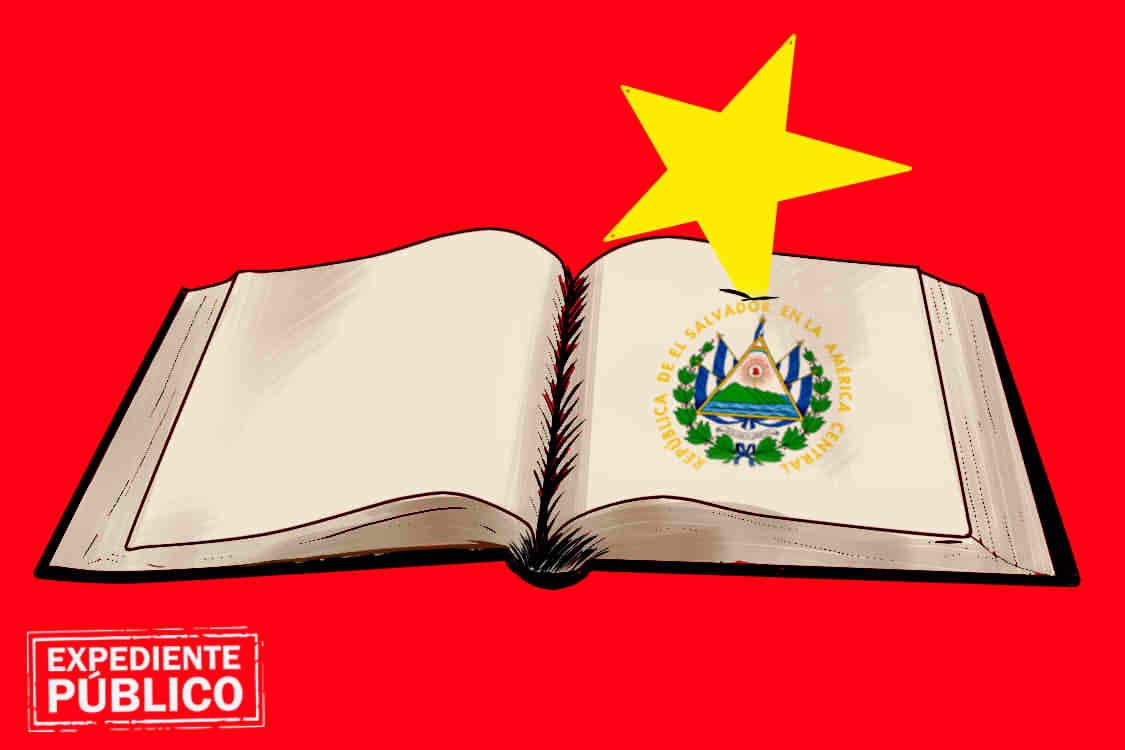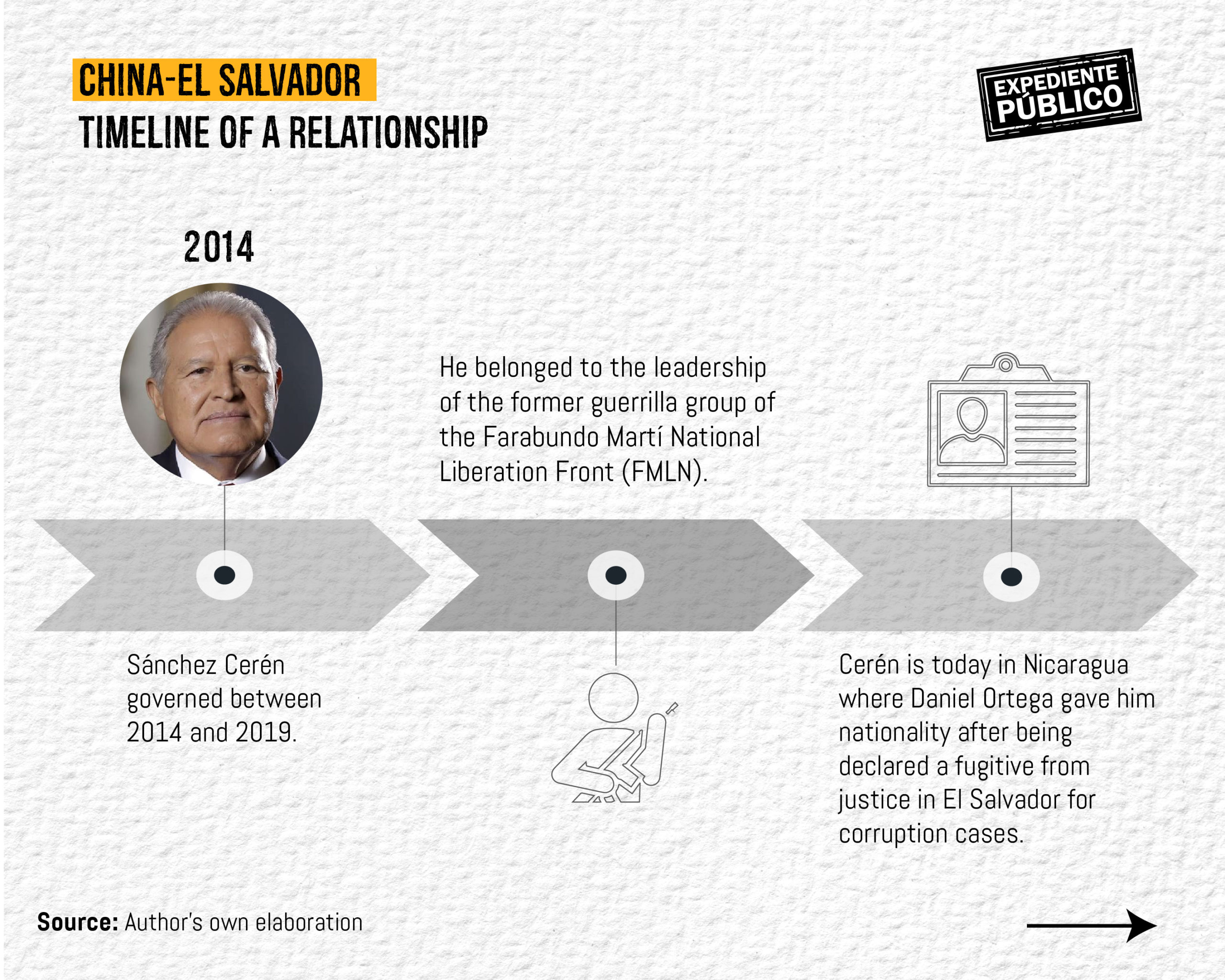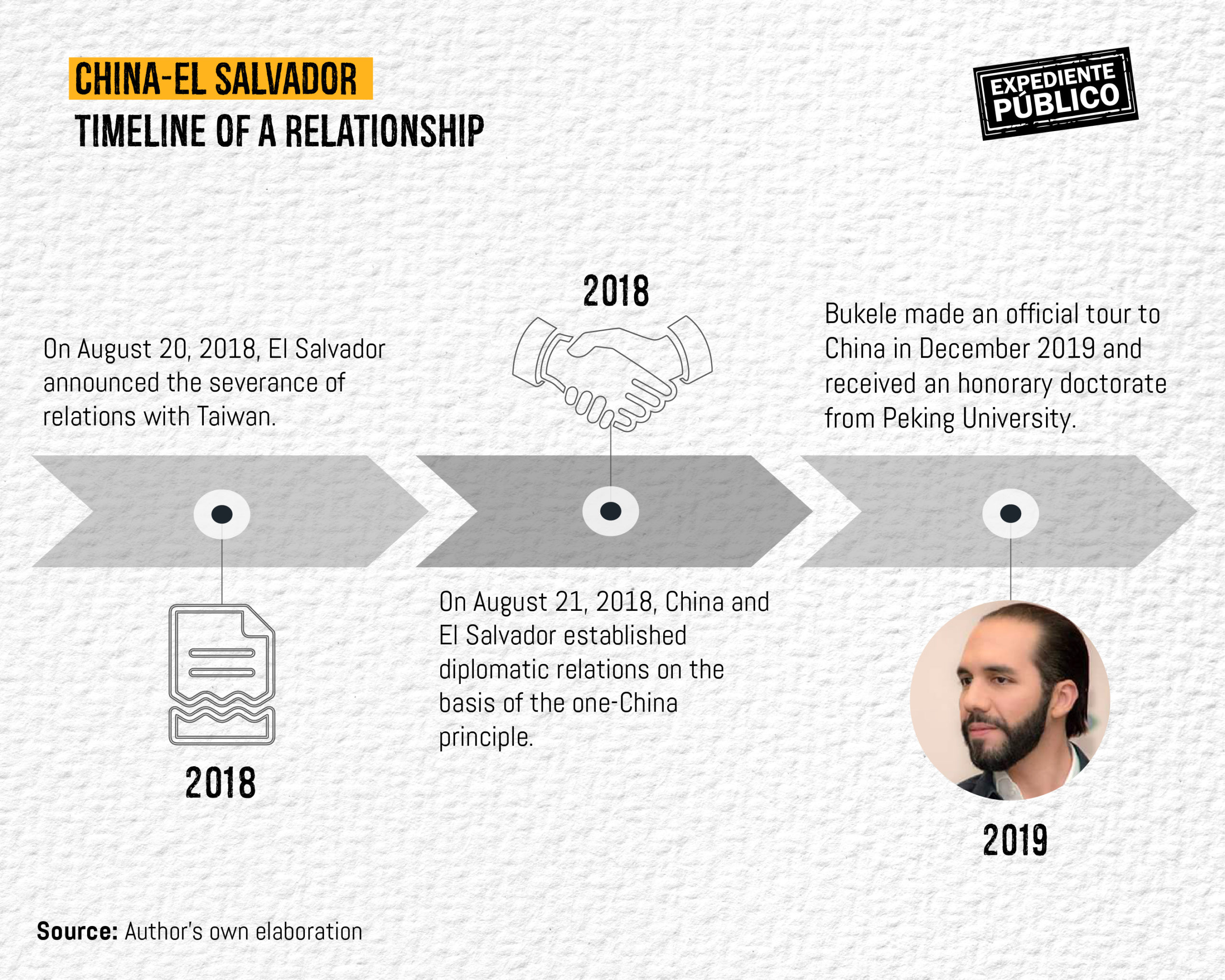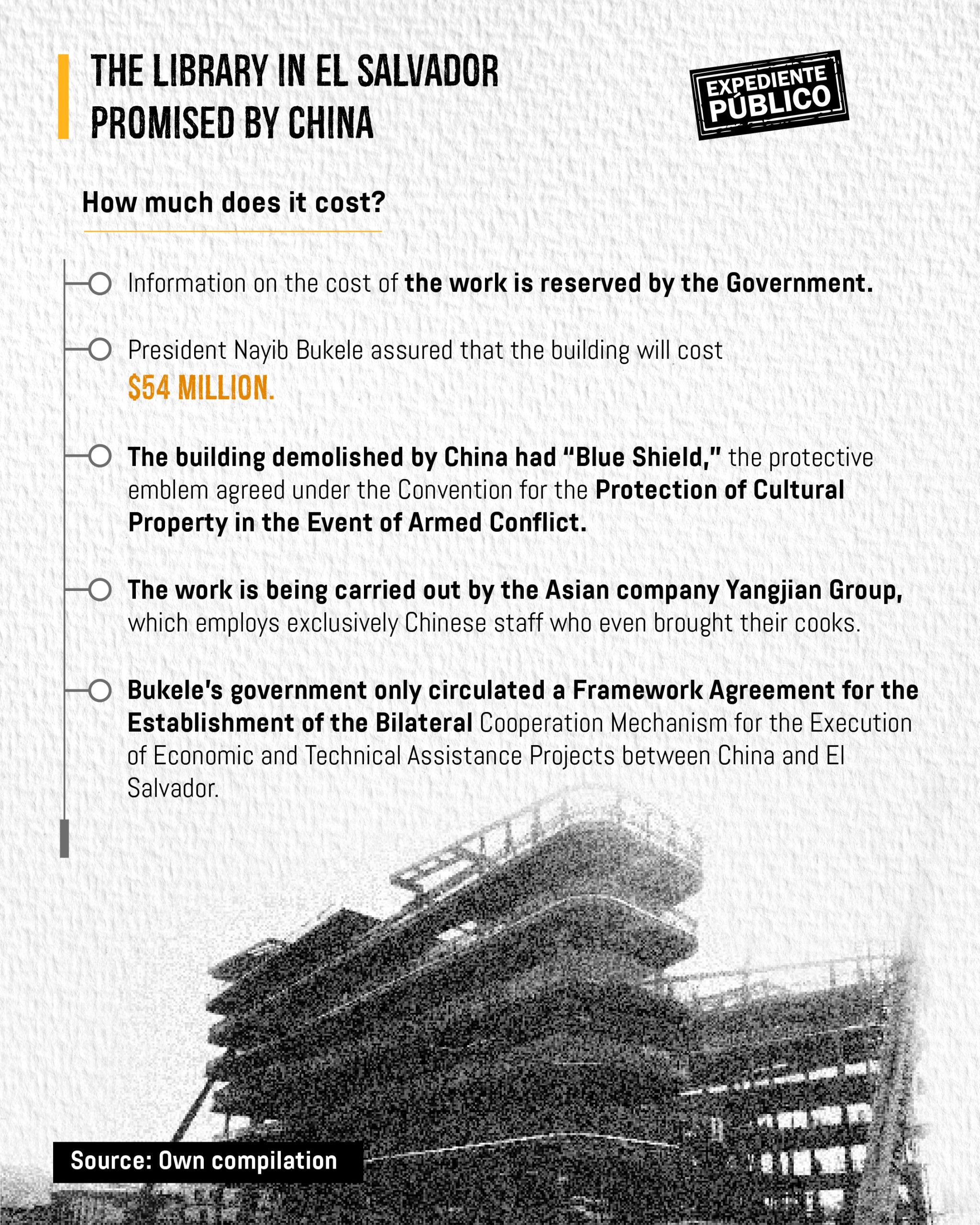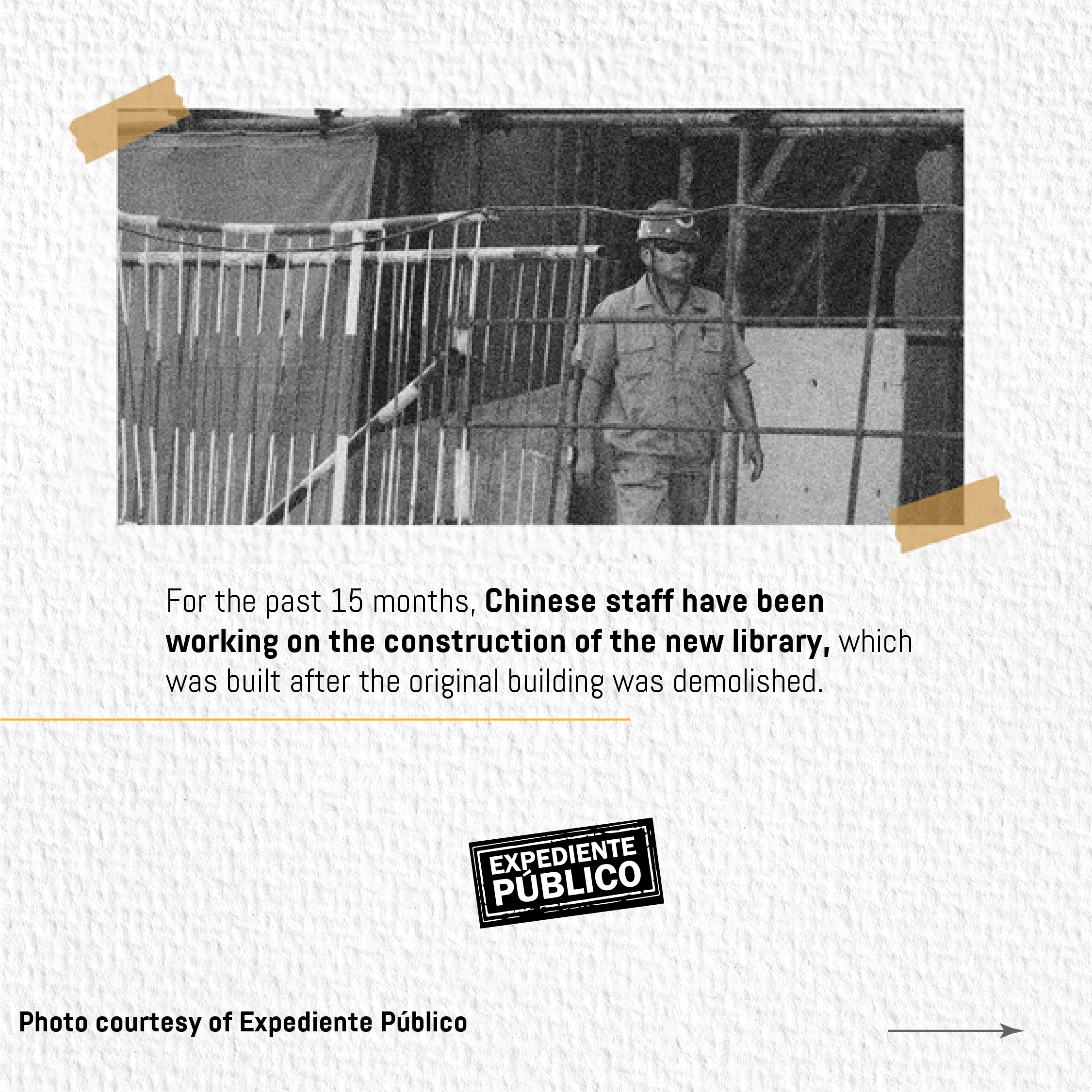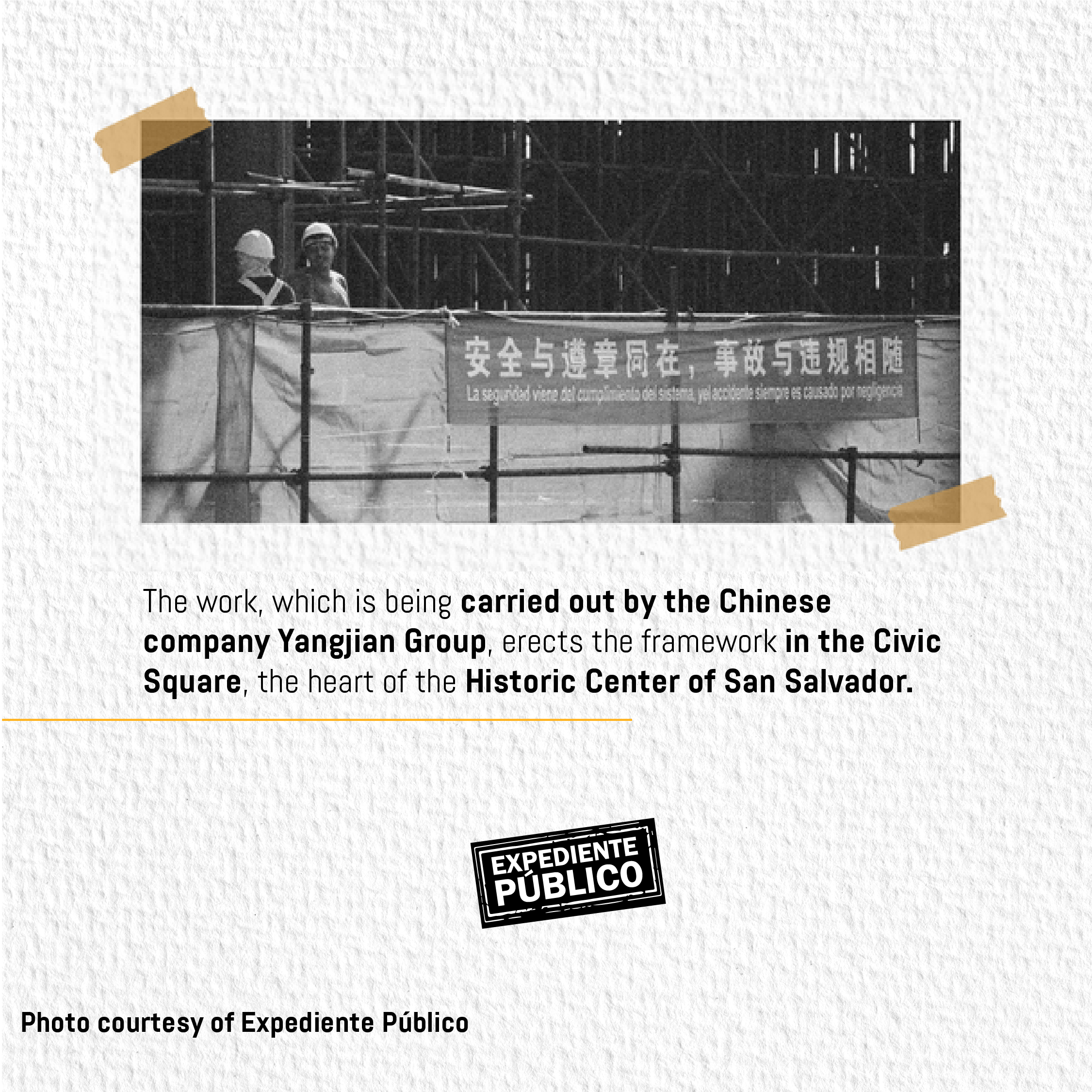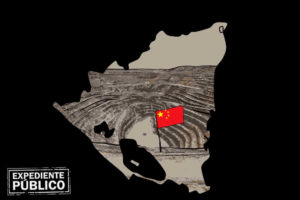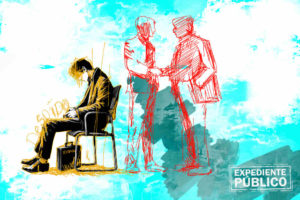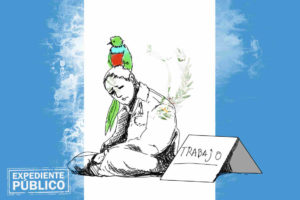* China erects the new national library of El Salvador in complete secrecy.
** The building, located in the heart of the historic center, is the second visible work resulting from Chinese cooperation in this Central American country.
** Last February 2022, Bukele inaugurated the work, which was scheduled to be completed within eight months, but a year later, construction is progressing late.
Eric Lemus / Expediente Público
On the day that Nayib Bukele inaugurated the construction of the new national library, he assured that the Salvadoran State would not spend anything because everything would be the result of the Asian donation and that it would be open 365 days a year and 24 hours a day.
“This is a donation, a collaboration of the Government of the People’s Republic of China, a donation that we talked about in a meeting with President Xi Jinping, to whom we extend our gratitude for this great work,” he said on Thursday, February 3 last year.
The event, organized at dusk, served to illuminate with floodlights the heart of the city that encompasses the National Palace, a neoclassical building dating from the early 20th century, and the Metropolitan Cathedral, where the remains of St. Romero of America, the archbishop killed by a sniper on March 24, 1980, lie.
Bukele said the building would cost $54 million and that it simulates an open book, but inspired by El Salvador’s reefs, waves and volcanoes, which would be “a legacy not only for us but for future generations.”
See also: China and its level of reach in three Central American countries
In December 2021, the Assembly approved special provisions to speed up the construction of the building. The work is being carried out by the Chinese construction firm Yanjian Group and only Chinese workers are involved in the construction and have even brought their own cooks.
Since that declaration, the Government has only circulated a Framework Agreement for the Establishment of the Bilateral Cooperation Mechanism for the Implementation of Economic and Technical Assistance Projects between the two countries.
The bibliographic collection
The Salvadoran National Library was founded on July 5, 1870 by decree of the Ministry of Foreign Affairs and by instruction of the former president of the Republic, Francisco Dueñas, who acquired a bibliographic collection of 6,000 volumes purchased from Mexican General Federico Larraínzar.
The works covered all the Greek and Latin classics, as well as the Italian, French, English, German and Spanish classics, and several encyclopedias that were in the hands of Larraínzar and that belonged to Cardinal Luigi Lambruschini, former secretary of state of Pope Gregory XVI.
“We don’t know what the reasons may have been for acquiring this collection that expressed a rather antiquated and reactionary vision of culture, very little in tune with the liberal and positive spirit of the late nineteenth century,” Ricardo Roque Baldovinos, a professor at the José Simeón Cañas Central American University (UCA), told Expediente Público.
Over the next century, the institution went through several crises due to the lack of a permanent headquarters. It was in a building of the University of El Salvador (UES), next to the current Cathedral, until it was moved to its own building, but it unfortunately succumbed in the earthquake of October 10, 1986.
Currently, its entire catalog has been moved to a temporary headquarters where the Ministry of Culture maintains that it safeguards all the content that covers 92,047 different titles.
Wandering Heritage
Salvadoran academic researcher Carlos Cañas Dinarte, who is based in Barcelona, told Expediente Público that “the library has seen all its bibliographic and newspaper heritage endangered in all those years that it wandered until it reached the last place,” where the Chinese company Yanjian is now building the new foundations.
Cañas recalled that the decision taken by the Ministry of Culture of Bukele’s government went over the Special Law for the Protection of Cultural Heritage.
The building demolished by China had “Blue Shield,” which is the protective emblem agreed within the framework of the Convention for the Protection of Cultural Property in the Event of Armed Conflict, signed in the city of The Hague in 1954.
“When the proposal is made to build the library donated by China, the provision of the UNESCO Blue Shield is violated and the provision that the building and its contents are the heritage of Salvadorans is violated,” Cañas said.
“The Chinese architect’s proposal completely violates the environment of that area and forces the demolition of other structures that were around,” he added to Expediente Público.
Promises of $500 Million
In May 2021, the Legislative Assembly, which is controlled by the ruling New Ideas (NI) party, ratified an agreement that Bukele signed with his Chinese counterpart, Xi Jinping, during a presidential tour in December 2019, where he was awarded an honorary doctorate by Peking University.
The Secretariat of Communications of the Presidency released the photographs in which an exultant Bukele receives the title from the hands of the president of the National People’s Congress, Li Zhanshu.
The Salvadoran leader announced that he obtained a $500 million agreement that was destined for the construction of the library, a new stadium, a new pier in the port of La Libertad, and a water purification plant in Lake Ilopango. The water resource is of volcanic origin and contains arsenic and boron in its waters.
In December 2021, Congress made special provisions to speed up construction of the building.
So, on the night of the library’s launch, Bukele remained true to his slogan, anticipating that it would be “the largest in all of Latin America” and that it would be ready in eight months. But the promise is still in the works.
A Building: A Symbol
A little over a year ago, Ou Jianhong, who is now China’s former ambassador to El Salvador, said the library represents “the beautiful hope of the two peoples to help each other and prosper together.”
“The National Library of El Salvador is a strong and palpable manifestation of the results of cooperation between the two countries,” Ou said, calling the work “a new monument of mutually beneficial cooperation between China and El Salvador.”
Ou was recently replaced by Zhang Yanhui, who is the new ambassador of the People’s Republic of China to El Salvador.
Also: Las promesas rotas de China en Centroamérica y la diplomacia de las vacunas
Zhang presented credentials on February 2 and reiterated Beijing’s willingness to continue cooperating with the Central American country.
A few days later, Zhang hosted an honorary dinner to which he invited pro-government deputies from the Salvadoran Congress and previously selected journalists.
Sympathy and restlessness
Regarding the remains of the old building, opinion is diverse among those who depend on the underground economy in the Historic Center to survive.
Juan Carlos Avelar, who sells plastic bags, told Expediente Público that despite the delay, “(the building) is looking very nice.”
But a vendor near the construction site avoids identifying herself.
“Look, now saying something is scary because today they have our mouths shut. What one says is nothing to what they invent,” she warns.
On the other hand, seamstress Ana Henríquez believes that the work will always bring benefits.
“People are grieving because they’re going to be removed and they earn their daily pennies here. It’s more difficult for them to move them somewhere else, but everything has a solution in life,» she predicts to Expediente Público.
While Pablo, who sells used books next to the perimeter wall of the works, laments that “there are many young people who do not know how to read or write (…) They don’t know where the table of contents is, they don’t know what the prologue is, they don’t know what a synthesis is.”
“Our people need to read culture,” he says.
Lack of respect for the law
For Federico Hernández, the former president of the former National Council for Culture and Art (Concultura), which became the Ministry of Culture in 2014, there is “nothing to be surprised about” regarding what happened.
“The government is proposing construction dates that seem to be pulled out of their sleeves. It was obvious that a work like the one they plan to do in the historic center was going to take longer,” Hernández told Expediente Público.
“I am more concerned about the issue of respect for the Special Law for the Protection of Cultural Heritage (LEPPC),” Hernández said.
“First, they violated it by demolishing the old building where the National Library was, since it was a heritage building. They simply threw it down and no one enforced the law. In this case, the Ministry of Culture,” he stated.
Meanwhile, lawyer and writer Alfonso Fajardo explained to Expediente Público that “it is contradictory that the same State that has issued protection measures on the building that housed the National Library is in charge of violating or infringe its own resolutions of protection over the property.”
Fajardo is an expert in copyright law and points out that the government trampled on the LEPPC and the decision caused the Ministry of Culture to incur the crime of “Infringement of the measures of registration, control, circulation and protection of Cultural Property.”
Salvadoran law is quite lax in this area because it punishes anyone who violates article 223 of the Penal Code with a sentence of one to two years.
“The Historic Center of each country is characterized precisely by the preservation of its ancient architecture. That is its tourist attraction: to be able to travel through time to the old city, to the ancient epicenter where religion and the legislative, judicial and executive powers converged, most of the time, and that is precisely the attraction of remaining and persisting despite time,” Fajardo reflected.
Demolish or conserve
The progress of the works is observed daily by the people of the capital who cross the Civic Square every day, where an equestrian statue dedicated to Gerardo Barrios, the soldier who introduced coffee cultivation in the country at the end of the 19th century, is erected.
The parishioners who rest in the few trees offered by the place, witnessed the systematic demolition of the entire block that adjoined the library.
The government also acquired the surrounding properties because the quadrant housed the birthplace of the Central American poet José Batres Montúfar and was also the residence of the independence hero Santiago Rubides José Célis in the 19th century, according to Cañas Dinarte.
“In addition, Legislative Decree 513 dated April 22, 1993, granted it the status of a cultural asset of the country. The Special Law on Cultural Heritage gives libraries and archives this status because they are part of the Salvadoran treasure. But this government didn’t care about that,” he adds.
For his part, Hernández, in his capacity as former president of Concultura, criticized that “according to the Heritage Law, no monumental work can be built in any of the protected grids of the Historic Center because this would break the so-called architectural line of the area.”
Of all the works announced, to date, the building that simulates an open book in the heart of the city is the one that shows progress, despite the fact that it should have been completed in September last year, and where the rule is the opacity of the entire process.
In fact, the government declared the cooperation agreement with China reserved for seven years.
“In the future, when China finally finishes that, we’re going to have a very modern structure that has no relation to the rest of the urban landscape and the next phase will come, which will be, what will house it,» he concluded.

